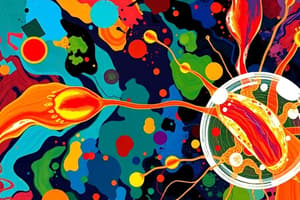Podcast
Questions and Answers
Where does fertilization occur in mammals?
Where does fertilization occur in mammals?
- In the uterus
- In the vagina
- In the cervix
- In the oviduct (correct)
What physiological change occurs in sperm that enhances their ability to fertilize an egg?
What physiological change occurs in sperm that enhances their ability to fertilize an egg?
- Decreased temperature sensitivity
- Reduced velocity
- Hyperactivity (correct)
- Motility decrease
What is the primary role of hyaluronidase during fertilization?
What is the primary role of hyaluronidase during fertilization?
- To inhibit sperm motility
- To assists in penetrating the corona radiata (correct)
- To bind to the zona pellucida
- To trigger the acrosome reaction
Which of the following sperm characteristics is altered during capacitation?
Which of the following sperm characteristics is altered during capacitation?
What mechanism leads to the slow block to polyspermy during fertilization?
What mechanism leads to the slow block to polyspermy during fertilization?
What is the viability period of the ova after ovulation in mammals?
What is the viability period of the ova after ovulation in mammals?
What is one of the first events that occur during the acrosome reaction?
What is one of the first events that occur during the acrosome reaction?
Which substance plays a role in helping sperm cross the zona pellucida?
Which substance plays a role in helping sperm cross the zona pellucida?
What is the first phase of sperm penetration during fertilization?
What is the first phase of sperm penetration during fertilization?
Which substance induces the acrosome reaction during fertilization?
Which substance induces the acrosome reaction during fertilization?
During the acrosome reaction, what enzymes are released by the sperm?
During the acrosome reaction, what enzymes are released by the sperm?
What change prevents polyspermy during fertilization?
What change prevents polyspermy during fertilization?
What occurs immediately after the sperm successfully penetrates the zona pellucida?
What occurs immediately after the sperm successfully penetrates the zona pellucida?
What is the role of calcium ions (Ca2+) in fertilization?
What is the role of calcium ions (Ca2+) in fertilization?
How does the oocyte membrane become impenetrable after fertilization?
How does the oocyte membrane become impenetrable after fertilization?
Which protein plays a critical role in sperm binding to the zona pellucida?
Which protein plays a critical role in sperm binding to the zona pellucida?
What happens to the sperm mitochondria during fertilization?
What happens to the sperm mitochondria during fertilization?
What is the fertilization cone?
What is the fertilization cone?
What is the result of the oocyte undergoing its second meiotic division?
What is the result of the oocyte undergoing its second meiotic division?
Which layer around the egg is crucial for binding and inducing the acrosome reaction?
Which layer around the egg is crucial for binding and inducing the acrosome reaction?
What mechanism is primarily responsible for the fast block to polyspermy?
What mechanism is primarily responsible for the fast block to polyspermy?
What type of change does the zona reaction induce after sperm contact?
What type of change does the zona reaction induce after sperm contact?
Flashcards are hidden until you start studying
Study Notes
Fertilization
- Occurs in the oviduct of mammals
- Ova remains viable for 12-24 hours after ovulation
- Sperm remains viable for up to 72 hours inside the female reproductive tract
Mechanisms of Fertilization
- Sperm undergoes a process called capacitation to become competent to fertilize the egg
- Capacitation involves changes to sperm motility and structure occurring in the female reproductive tract
- Sperm undergoes a process called the acrosome reaction to penetrate the zona pellucida surrounding the egg
Capacitation
- Occurs within the female reproductive tract
- Involves interactions between sperm and mucosal surfaces
- Removal of glycoprotein coat and seminal plasma proteins from the sperm plasma membrane
- Capacitated sperm exhibit increased motility and force
- Capacitated sperm possess hyaluronidase enzymes to penetrate the extracellular matrix of cumulus cells
- Sperm exhibit the ability to sense temperature differences and preferentially swim towards warmer sites
- Capacitated sperm sense a thermal gradient of 2 degrees Celsius
- Sperm also sense molecules secreted by the oocyte and cumulus cells, such as progesterone
- Progesterone binds to receptors on the sperm tail, activating calcium channels and increasing sperm activity
Acrosome Reaction
- Triggered after sperm binds to the zona pellucida (ZP)
- Release of enzymes such as acrosin and trypsin-like substances from the acrosome
- Occurs in three phases:
- Penetration of the corona radiata
- Penetration of the zona pellucida
- Fusion of the oocyte and sperm membranes
Phases of Fertilization
- Phase 1:
- Millions of sperm reach the fertilization site
- Capacitated sperm pass through corona cells
- Phase 2:
- The zona pellucida (ZP) is a glycoprotein shell facilitating sperm binding and inducing the acrosome reaction
- Binding and the acrosome reaction involve interaction with ZP3
- Phase 3:
- Release of acrosin allows sperm to penetrate the zona pellucida, establishing contact with the oocyte membrane
- Changes in zona pellucida permeability occur when the sperm head contacts the oocyte surface
- Release of lysosomal enzymes from cortical granules lining the oocyte plasma membrane (zona reaction)
- Only one sperm typically penetrates the egg, despite other sperm being embedded in the zona pellucida
Gamete Fusion
- Initial adhesion of sperm to the oocyte involves interaction between integrins on the oocyte and their ligands, disintegrins, on the sperm
- Fusion of the sperm and oocyte plasma membranes occurs, forming a fertilization cone
- The plasma membrane covering the acrosomal head cap disappears during the acrosome reaction
- Fusion of the acrosomal head cap and the oocyte plasma membrane leads to the formation of a fertilization cone
Polyspermy Prevention
- Polyspermy, the fertilization of an egg by multiple sperm, is prevented by the fast and slow blocks:
- Fast block: Changes in the electric potential of the egg plasma membrane
- Slow block:
- Cortical granule reaction, where enzymes are released to modify the zona pellucida, preventing further sperm binding
- Zona reaction involves the inactivation of species-specific receptor sites on the zona pellucida
- The Juno protein plays a role in slow block by preventing sperm fusion with the oocyte membrane
Fusion of Genetic Material
- The male pronucleus enlarges while the oocyte completes its second meiotic division
- Both pronuclei lose their nuclear envelopes and become indistinguishable
- The centrosome from the male pronucleus produces asters and contacts the female pronucleus
- Each pronucleus migrates toward the other, replicating its DNA during the migration
- The nuclear envelopes break down
- Glutathione in the egg reduces disulfide bonds and uncoils sperm chromatin
- The sperm contributes the pronucleus, mitochondria, and centriole
- Mitochondria from the sperm are degraded in the egg cytoplasm
- Chromatin condenses into chromosomes which orient themselves on a common mitotic spindle
Calcium Role in Embryo Development
- Calcium release activates metabolic reactions involved in respiration and protein synthesis
- Increased respiration and protein synthesis contribute to embryo development
Summary
- The male nucleus enters the egg cytoplasm and becomes the male pronucleus
- The fusion of the sperm and egg triggers the oocyte nucleus to complete its second meiotic division, forming a polar body
Studying That Suits You
Use AI to generate personalized quizzes and flashcards to suit your learning preferences.



